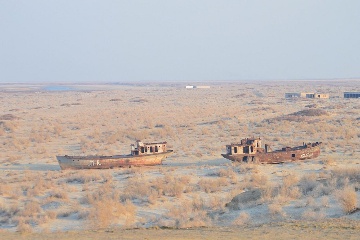The Aral Sea Ship Cemetery, located near Moynaq in northwestern Uzbekistan, stands as a haunting testament to one of the worst environmental disasters of the 20th century. Once a bustling fishing port, Moynaq thrived on the shores of the Aral Sea, which was the fourth-largest lake in the world and a vital economic resource for the region. However, the sea has shrunk dramatically since the 1960s, leaving behind a desolate landscape dotted with the rusted remains of abandoned ships.

The ship cemetery is a stark reminder of the sea's former glory. What was once a thriving harbor is now a desert scattered with the skeletal remains of fishing vessels. These ships, now stranded on dry land, serve as eerie monuments to the environmental catastrophe that has befallen the region. The area has become a popular destination for tourists, photographers, and filmmakers, who come to witness and document the tragic decline of the Aral Sea.
The Aral Sea, once the world's fourth largest lake, covered 68,000 square kilometers in 1960. Today, it's only 10% of its 1960 size.The primary cause of the Aral Sea's drying is the diversion of its feeder rivers for large-scale irrigation projects, mainly for cotton production. In the 1960s, the Soviet Union implemented extensive irrigation systems to convert the arid lands of Central Asia into cotton fields. This led to the redirection of the Amu Darya and Syr Darya rivers, which were the main sources of water for the Aral Sea. As a result, the sea began to shrink rapidly, losing about 90% of its original size by the 2010s.
The consequences of this environmental disaster have been severe. The fishing industry, which once supported over 40,000 jobs in Moynaq alone, collapsed as the water levels dropped and salinity increased, making the water uninhabitable for fish. The local climate has also changed dramatically, with the region experiencing more extreme temperatures and frequent dust storms carrying toxic salts and pesticides.
Despite the ongoing challenges, there are some efforts to rehabilitate the affected areas. Uzbekistan has launched initiatives to combat desertification and restore vegetation, planting millions of saxaul shrubs to stabilize the soil and reduce the impact of dust storms. These efforts, while still in their early stages, offer a glimmer of hope for the future of this once-thriving region. However the Aral sea’s drying seems inevitable.




































